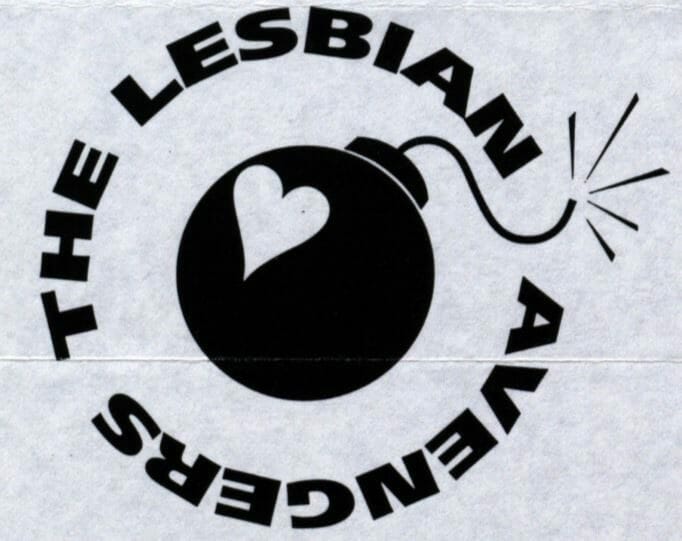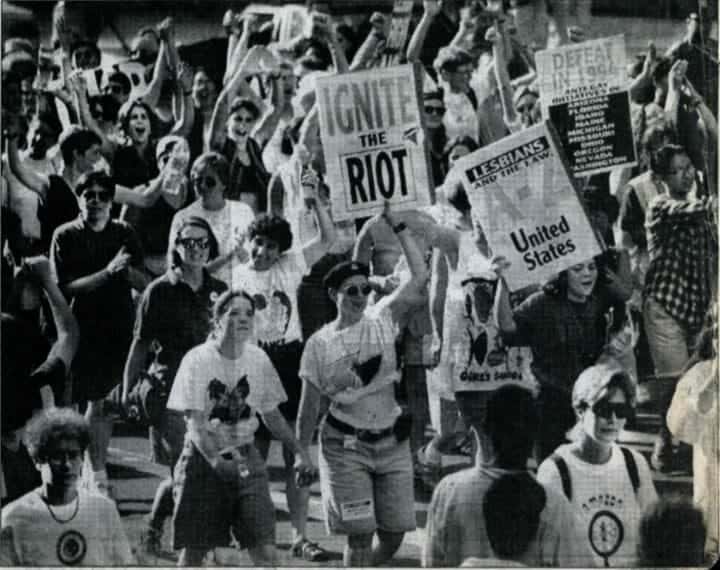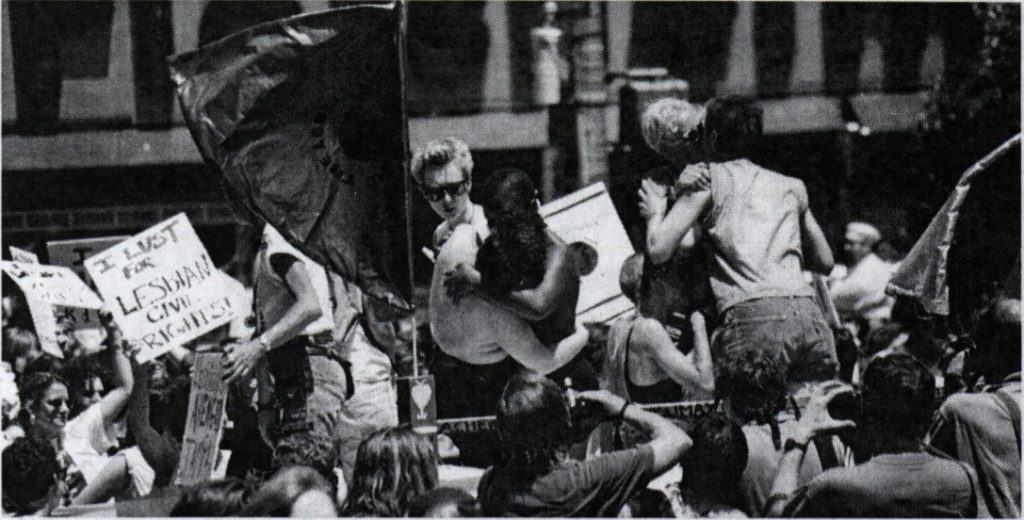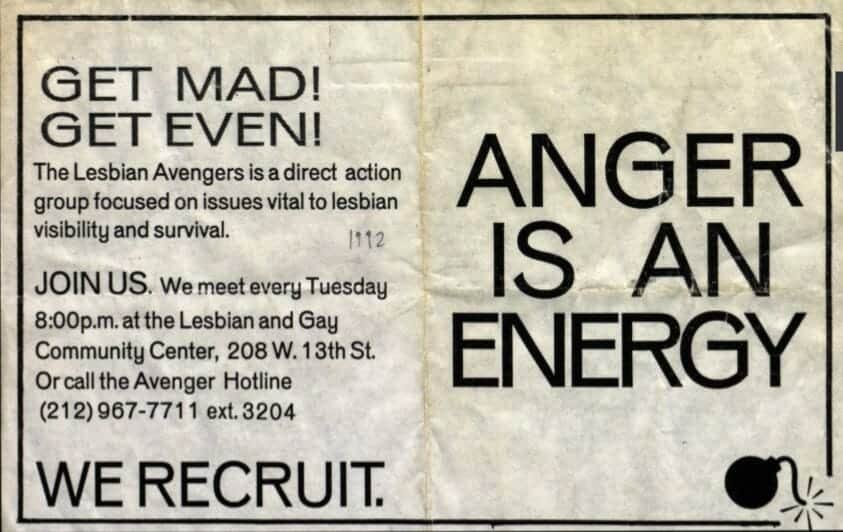│By Ellen Grace Lesser, Gale Ambassador at the University of Exeter│
I was so excited to be given the opportunity to be one of the first people to undertake research in the latest module of Archives of Sexuality and Gender. The fourth module in the series, International Perspectives on LGBTQ Activism and Culture focuses on the history of LGBTQ+ activism across the world. After exploring the archive, I want to share the story of the Lesbian Avengers and how their performative attempts at intersectionality ultimately led to their downfall.
The Lesbian Avengers: A Militant Lesbian Activism Group
An advert for a dance party hosted by the Lesbian Avengers in the early 1990s describes the group thus: “THE LESBIAN AVENGERS is a direct-action group focused on issues vital to lesbian survivability and visibility” (p.23). Indeed, their campaigns were certainly geared towards visibility. In a 1995 article by New York-based freelance writer and editor Irene Elizabeth Stroud some of the group’s more fantastical campaigns were described: “The Avengers specialise in hit-and-run actions and high-performance street theater: they eat fire, serenade right-wing Christian women outside their homes, hand out chocolate kisses to people on the street. They’ve handed schoolchildren purple balloons that said “Ask about lesbian lives.” The Avengers are less-talk-more-action activists” (sic, p.117).

Their logo incorporates a bomb, indicating their militancy, and although they were mainly based in New York they did not shy away from travelling to take part in activism or from looking beyond the issues plaguing lesbians in New York. The Avengers called for a protest against the potential banning of “Queer-Specific Anti-Discrimination Laws” in Colorado (p.130) and arranged a freedom ride to Maine to protest anti-queer legislation (p.12).

Lesbian Avengers, New York (Founding Chapter) [1 of 2]. 1992-1996. MS Organization Files from the Lesbian Herstory Archives ORGFIL0857-001. Lesbian Herstory Archives. Archives of Sexuality and Gender, https://link.gale.com/apps/doc/ERLKYS481411476/GDCS?u=webdemo&sid=GDCS&xid=c96f938b (p.12).
A display of intersectionality
Over time, the Lesbian Avengers grew into a national (and international) organisation, with groups across the world. Geographical spread is an important part of activism, especially when dealing with a global issue such as queerphobia and related prejudices, but in my opinion, increasing breadth is not as important as increasing depth through an appreciation of and commitment to intersectionality.

Lesbian Avengers, New York (Founding Chapter) [1 of 2]. 1992-1996. MS Organization Files from the Lesbian Herstory Archives ORGFIL0857-001. Lesbian Herstory Archives. Archives of Sexuality and Gender, https://link.gale.com/apps/doc/ERLKYS481411476/GDCS?u=webdemo&sid=GDCS&xid=c96f938b (p.96).
The Lesbian Avengers did make strides towards intersectionality. In October 1992, they held a vigil for Hattie Mae Cohens and Brian Mock, “a Black lesbian and a disabled gay man”, who had been murdered the month before. The New York chapter also “sought the participation of other lesbian groups in [New York], many of which are neighborhood-based in predominantly Black and Latino sections of the city … or are organized along racial and ethnic lines”, including the fellow lesbian activist group, Las Buenas Amigas (sic, p.118).
CITYAXE and the importance of true intersectionality
All was not as it seemed, however. Throughout the lifetime of the Lesbian Avengers, another group grew within it: CITYAXE. CITYAXE described themselves as a “project of the Lesbian Avengers dedicated to instigating and organizing multicultural, multiracial activism by and for New York City lesbians” (sic, p.97) which included in its founding membership Lidia Medina, who had been a member of both the Lesbian Avengers and Las Buenas Amigas (p.119).
In May 1995, the founding members of CITYAXE wrote an open letter to the leadership of the Lesbian Avengers which was read out at one of the group’s meetings. The letter announced that CITYAXE was breaking away from the Lesbian Avengers and that six of the seven founding members of CITYAXE were also terminating their membership of the Lesbian Avengers. The reason for this schism was, in CITYAXE’s own words, due to their coming “to the conclusion that a multiracial, multicultural lesbian activist project is not viable in the context of an actively hostile white, racist group.” The Lesbian Avengers were 92% white and CITYAXE accused them of showing no interest in criticising themselves or confronting instances of racism within their ranks (pp.97-100).
Four days after this letter was read out, the founding members of CITYAXE (save for Lidia Medina) gave personal statements as to why they were leaving the Avengers. Across the statements, the grievance is clear: the Lesbian Avengers were not doing enough to properly represent lesbians of colour, nor were they interested in making their own group a safe and accessible place for lesbians of colour to engage in intersectional activism. Among the leavers was Ana Simo, one of the founding members of the Lesbian Avengers, who was disgusted that “CITYAXE was drummed out of the Avengers by relentless hostility” and called for a rebuilding of the entire Lesbian Avengers based on critical self-examination (pp.101-102).
“This is not the end:” Simo wrote, “it’s a chance to start all over again” (p.101).

Lesbian Avengers, New York (Founding Chapter) [1 of 2]. 1992-1996. MS Organization Files from the Lesbian Herstory Archives ORGFIL0857-001. Lesbian Herstory Archives. Archives of Sexuality and Gender, https://link.gale.com/apps/doc/ERLKYS481411476/GDCS?u=webdemo&sid=GDCS&xid=c96f938b (p.62).
The rise and fall of the Lesbian Avengers highlights the importance of intersectionality in LGBTQ+ activism. Queerness is not reserved for white people, and this should be recognised. LGBTQ+ activism has never happened without queer people of colour, nor should it ever happen without queer people of colour. To pretend that such a thing is even possible is to sow the seeds of failure.
Interested in reading more about LGBTQ+ issues and activism? Click for post threads on activism, lesbian and LGBTQ.
Blog post cover image citation: Lesbian Avengers, New York (Founding Chapter) [2 of 2]. 1992-1998. MS Organization Files from the Lesbian Herstory Archives ORGFIL0857-002. Lesbian Herstory Archives. Archives of Sexuality and Gender, https://link.gale.com/apps/doc/FCEEQP148815513/GDCS?u=webdemo&sid=GDCS&xid=ab8ada07 (p.151).

